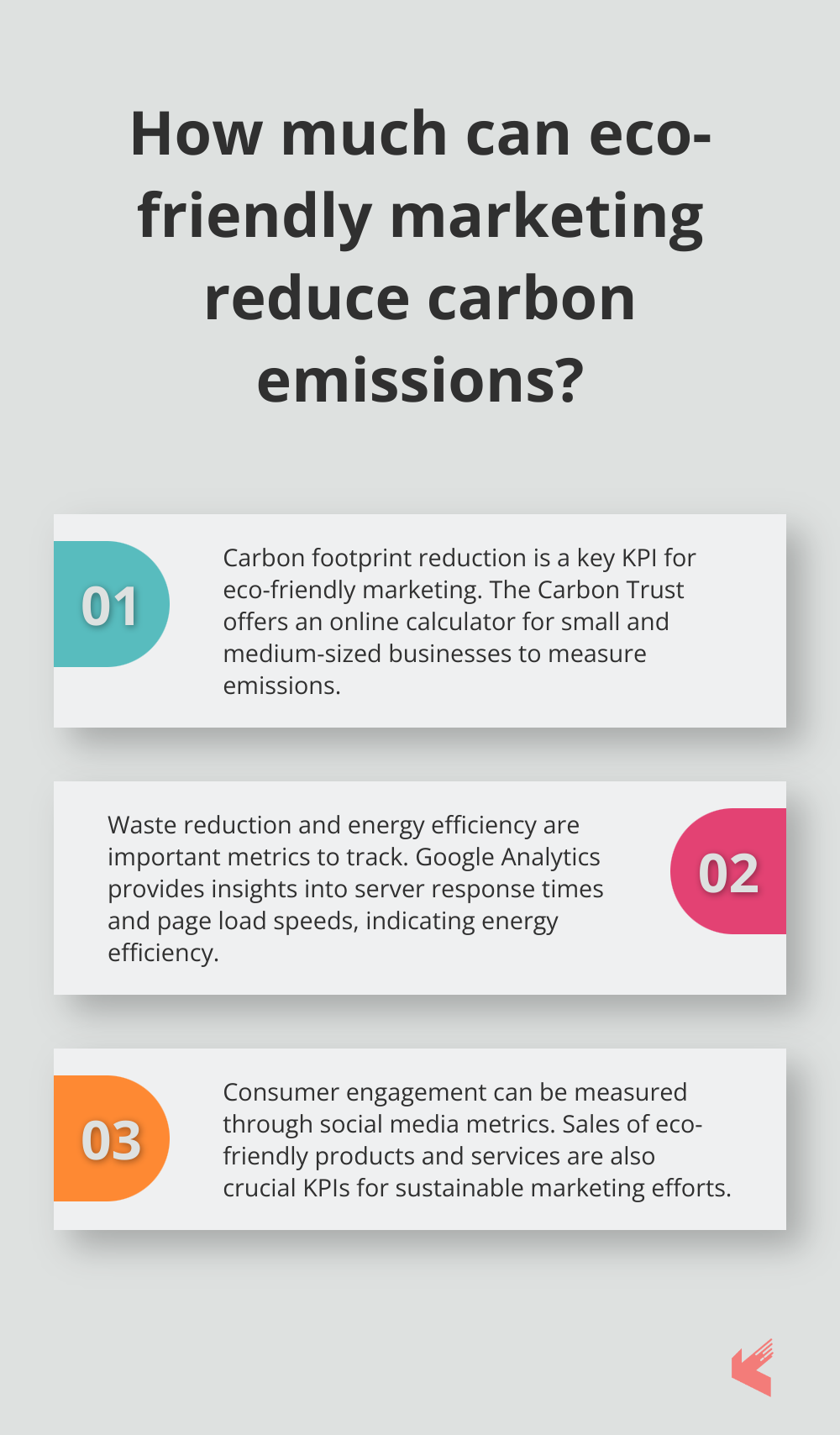At Karma Works Marketing, we’ve seen a surge in demand for eco marketing solutions. Businesses are realizing that sustainable practices aren’t just good for the planet-they’re good for the bottom line too.
In this post, we’ll explore how companies can implement eco-friendly marketing strategies that resonate with environmentally conscious consumers. We’ll cover practical steps, from digital-first approaches to sustainable packaging, that can make a real difference in reducing your marketing’s environmental impact.
What Is Eco-Friendly Marketing and what are eco marketing solutions?
Definition and Importance
Eco-friendly marketing promotes products, services, and brand values while minimizing environmental impact. It transcends the simple act of labeling products as “green.” Instead, it requires a fundamental rethinking of consumer communication methods that respect our planet’s resources.
The Environmental Cost of Traditional Marketing
Traditional marketing methods often exact a significant environmental toll. Print advertising, for instance, contributes to deforestation and water pollution. The American Forest & Paper Association reports that the United States uses about 68 million trees annually for paper and paperboard. Billboards and other outdoor advertising structures not only consume resources but also contribute to visual pollution and can harm local ecosystems.
Digital Marketing: A Greener Alternative?
Digital marketing often receives praise as a more eco-friendly option, but it’s not without environmental impact. Data centers, which power our digital world, consume vast amounts of energy. A study outlines an estimation of the global electricity usage that can be ascribed to Communication Technology (CT) in the coming decade. However, when compared to traditional methods, digital marketing generally offers a lower carbon footprint and more targeted reach, making it a preferred choice for eco-conscious brands.
Consumer Demand Drives Change
The shift towards eco-friendly marketing benefits both the planet and businesses. A recent IBM study found that nearly 6 in 10 consumers express willingness to change their shopping habits to reduce environmental impact. This growing consumer consciousness pushes brands to adopt more sustainable practices, including in their marketing efforts.
Authenticity: The Key to Success
Consumers have become increasingly adept at spotting “greenwashing” (the practice of making misleading environmental claims). Authentic eco-friendly marketing requires a holistic approach, from the products you sell to the way you communicate about them. It’s about walking the talk and maintaining transparency about your sustainability journey.

As we move forward, we’ll explore practical steps to make your eco marketing solutions more environmentally responsible and aligned with consumer values. The next section will discuss strategies for implementing eco-friendly marketing solutions that can transform your approach and resonate with your target audience.
How to Make Your Marketing Eco-Friendly
Embrace Digital-First Marketing
The shift to digital marketing offers significant environmental benefits. Digital marketing instead of traditional print media has a positive impact on the environment. Digital marketing channels allow for targeted, personalized communication with minimal physical waste.

To optimize your digital efforts for sustainability:
- Use efficient coding practices for websites and emails to reduce server load and energy consumption
- Compress images and videos to minimize data transfer
- These small steps can add up to significant energy savings over time
Rethink Your Packaging and Promotional Materials
When physical materials are necessary, opt for sustainable alternatives. Choose recycled or biodegradable packaging materials. Dell has successfully implemented packaging made from bamboo and mushrooms, developing new compostable packaging materials.

For promotional items, consider useful, long-lasting products that won’t end up in landfills. Reusable water bottles, tote bags made from organic cotton, or even digital gifts like e-books or app subscriptions can effectively promote your brand while minimizing waste.
Create Purpose-Driven Content
Content reigns supreme in modern marketing, but not all content is created equal from an environmental perspective.
Focus on creating high-quality, evergreen content that provides long-term value to your audience. This approach reduces the need for constant content production and helps establish your brand as a thought leader in sustainability.
When producing video content, consider the environmental impact of production. Opt for remote interviews or animation over resource-intensive location shoots when possible. The BBC has set a great example by committing to albert certification for all its TV productions, ensuring they meet high sustainability standards.
Partner for Impact
Collaborations with environmentally conscious organizations can amplify your eco-friendly marketing efforts. Look for partnerships that align with your brand values and can create meaningful change. For example, Adidas partnered with Parley for the Oceans to create a line of shoes made from recycled ocean plastic, turning an environmental problem into several eco marketing solutions.
Karma Works Marketing specializes in connecting brands with purpose-driven partnerships that enhance both marketing impact and sustainability efforts. Our network of eco-conscious organizations can help elevate your brand’s green credentials while making a real difference.
The implementation of these strategies requires commitment and creativity, but the potential rewards are substantial. You’ll reduce your environmental footprint and appeal to the growing segment of environmentally conscious consumers.
As we move forward, it’s important to consider how to measure the impact of these eco-friendly marketing efforts. The next section will explore key performance indicators and tools for tracking your progress in sustainable marketing.
Measuring Eco Marketing Solutions for Success
Defining Key Performance Indicators (KPIs)
To measure the impact of your eco-friendly marketing efforts, you must establish clear KPIs. These may include:
- Carbon footprint reduction: Easily calculate your emissions from fuel and processes and purchased electricity with this online tool for small and medium-sized businesses.
- Waste reduction: Measure the decrease in physical waste produced by your marketing campaigns (e.g., reduced paper usage or decreased packaging waste).
- Energy efficiency: Monitor the energy consumption of your digital marketing efforts. Google Analytics provides insights into server response times and page load speeds, which can indicate energy efficiency.
- Consumer engagement: Track metrics like social media mentions, shares, and comments related to your sustainable initiatives. Sprout Social offers comprehensive social listening tools for this purpose.
- Sales of eco-friendly products: If applicable, measure the increase in sales of your sustainable product lines or services.
Leveraging Technology for Impact Tracking
Several tools can help track and analyze your eco-friendly marketing efforts:
- Salesforce Sustainability Cloud: This platform helps businesses track and analyze their environmental impact across various operations (including marketing).
- GreenAdz: IAS has teamed up with Good-Loop, a purpose-led ad platform, to offer advertisers the opportunity to measure the carbon emissions generated by their digital ad campaigns.
- Website Carbon Calculator: This free tool estimates the carbon footprint of your website, helping you optimize for energy efficiency.
- Life Cycle Assessment (LCA) software: Tools like SimaPro or GaBi provide detailed environmental impact assessments of your products and marketing materials.
Effective Reporting and Stakeholder Communication
Transparent communication about your eco-friendly initiatives is essential. Here’s how to effectively report your progress:
- Create a sustainability report: Publish an annual report detailing your environmental goals, actions, and progress. The Global Reporting Initiative (GRI) provides standardized guidelines for sustainability reporting.
- Use data visualization: Tools like Tableau or Microsoft Power BI create compelling visual representations of your environmental data, making it more accessible to stakeholders.
- Integrate sustainability metrics into regular business reports: Include environmental KPIs alongside financial and operational metrics in your quarterly or annual reports.
- Engage employees: Use internal communication channels to keep your team informed about sustainability progress. This can boost morale and encourage further eco-friendly practices.
- Leverage social media: Share your sustainability achievements and challenges on social platforms. This transparency builds trust with consumers and demonstrates your commitment to eco-friendly practices.
Continuous Improvement and Adaptation
The measurement and reporting of your eco-friendly marketing efforts require ongoing attention. You should regularly review and adjust your metrics and reporting methods to ensure they align with your evolving sustainability goals and stakeholder expectations.

Try to identify areas for improvement based on your collected data. This proactive approach allows you to refine your eco-friendly marketing strategies and maximize their positive impact on both your business and the environment.
Final Thoughts
Implementing eco marketing solutions is not just a trend, but a necessity for businesses in today’s environmentally conscious market. Companies can reduce their environmental impact and appeal to eco-conscious consumers through digital-first approaches, sustainable packaging, and purpose-driven content. The long-term benefits of adopting sustainable marketing practices extend beyond environmental preservation to increased brand loyalty, improved reputation, and potential cost savings.

Continuous measurement, reporting, and improvement ensure that eco-marketing solutions remain effective and authentic. Businesses can track their progress and communicate their efforts transparently to stakeholders by leveraging the right tools and technologies. This approach builds trust and credibility while positioning companies for future success as environmental regulations tighten.
We at Karma Works Marketing help businesses navigate the transition to more sustainable marketing practices. Our expertise in eco-friendly marketing solutions can help your brand make a positive impact while achieving your business goals. Take the first step today and discover how eco marketing solutions can transform your business and your impact on the world.
